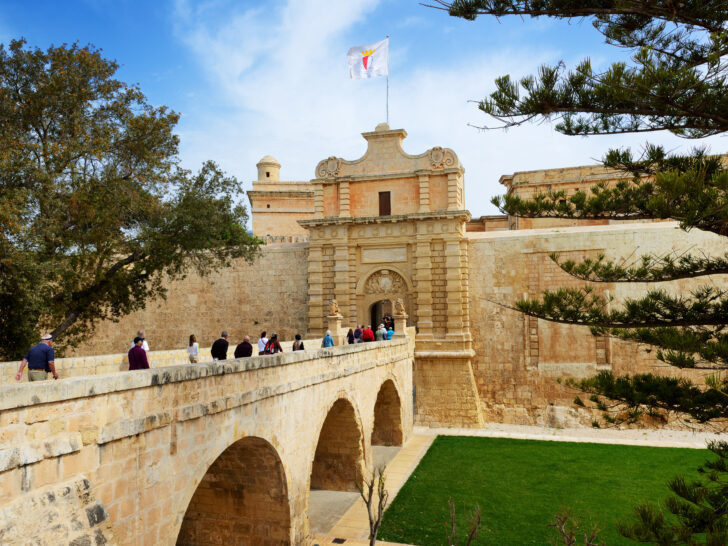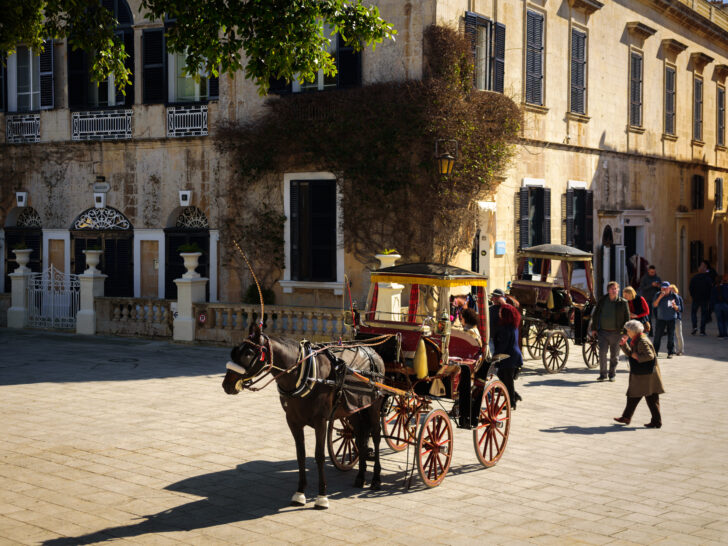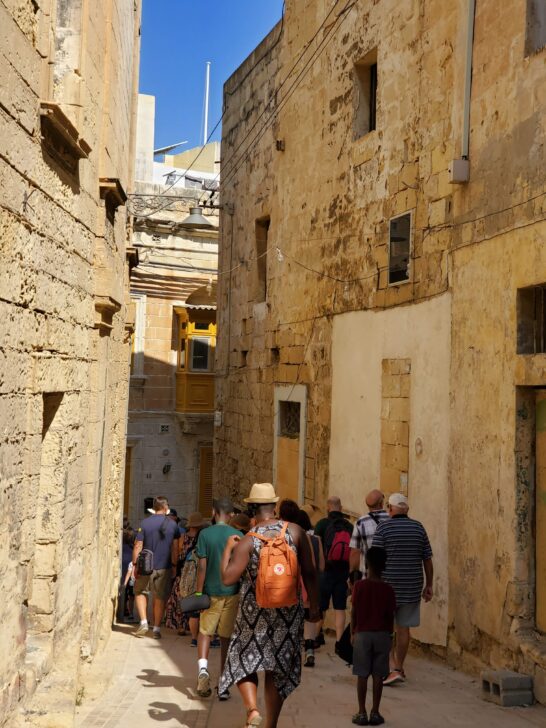Exploring the rich history and unique charm of Mdina, Malta, provides an unforgettable experience. Often called the “Silent City,” this ancient city offers a serene environment with narrow, winding streets and beautifully preserved architecture. Mdina’s tranquil atmosphere and historical significance make it a must-visit destination in Malta when visiting the Mediterranean.
7 Reasons to Visit Mdina
From its fascinating museums to its magnificent cathedrals, Mdina caters to all interests. Whether you’re a history buff, an architecture enthusiast, or simply looking to explore a unique locale, this city offers something for everyone. Discovering the many facets of Mdina will surely add depth and enjoyment to your Maltese adventure.

1) St. Paul’s Cathedral
St. Paul’s Cathedral in Mdina is a significant historical and architectural landmark. Dedicated to St. Paul the Apostle, this magnificent 17th-century structure is a testament to Malta’s deep-rooted Christian heritage.
Nestled in the heart of Mdina, the cathedral was built on the site where St. Paul is traditionally believed to have converted the Roman governor Publius to Christianity. (This belief is debated among historians). This makes it a site of profound religious importance.
The cathedral’s interior is as breathtaking as its exterior. Its intricate frescoes, elaborate marble floors, and grand vaulted ceilings offer a visual feast. The cathedral artworks reflect Malta’s rich artistic traditions and its historical ties to Christianity.
Visitors can also explore the cathedral museum, located across St. Paul’s Square. This museum houses an impressive collection of religious artifacts, paintings, and historical documents. One of the highlights is the collection of works by the German artist Albrecht Dürer. This combined experience provides a comprehensive look into Malta’s religious and artistic heritage.
The unique location of St. Paul’s Cathedral within the fortified walls of Mdina adds to its allure. The quiet, narrow streets leading to the cathedral enhance the sense of stepping back in time. A visit to St. Paul’s Cathedral offers a spiritual and cultural experience. It’s a must-see for anyone visiting Mdina.
2) Palazzo Falson
Palazzo Falson is a highlight in Mdina, Malta, for history enthusiasts. The second oldest building in the walled city, it dates back to the 13th century and offers a unique glimpse into Malta’s noble past.
This medieval townhouse was built as a family residence by the Maltese nobility. Today, Palazzo Falson operates as a house museum, featuring seventeen rooms filled with historic domestic belongings and numerous antique collections.
The museum is located in the heart of Mdina on Villegaignon Street. The building’s exquisite architecture and well-preserved interiors reflect its rich history.
The collections inside include books, artworks, and a variety of antiques. Captain Olof Frederick Gollcher, an artist, soldier, and collector who bought the palazzo in 1927, lived there.
This historic building offers a deep dive into Malta’s cultural heritage, from the exterior facade to the interior treasures.
3) Mdina Dungeons
Exploring the Mdina Dungeons offers a fascinating glimpse into Malta’s dark past. Located beneath the Magisterial Vilhena Palace, the dungeons are filled with historical artifacts and exhibits.
As you wander through the underground passageways and chambers, you’ll encounter scenes depicting various periods in Malta’s history. From Roman times to the era of the Knights and even Napoleon’s influence, the dungeons present a chilling yet educational experience. (Warning: Some of the displays are pretty gruesome!)
These dungeons are open to the public and provide a unique atmosphere with their authentic medieval setting. You’ll see life-sized figures and exhibits that narrate stories of drama, mystery, and historical events.

4) Bastion Square
Bastion Square offers some of the best views over Malta. This historic square is a must-visit for anyone interested in panoramic landscapes and architectural elegance.
Located in the heart of Mdina, Bastion Square provides sweeping island vistas. It’s an excellent spot for photography enthusiasts looking to capture the beauty of Malta from a unique vantage point.
Bastion Square was historically significant as it played a role during the Maltese uprising against French occupation. The Banca Giuratale, located nearby, was the meeting place of the National Assembly.
The architecture around Bastion Square reflects the rich history and cultural heritage of Mdina. Take your time to explore the surrounding buildings and appreciate the intricate details and craftsmanship.
To experience this part of Mdina, plan to visit early or late in the afternoon when the light is best for photos and the square is less crowded. This will enhance your experience and allow for peaceful contemplation of the remarkable views.
Explore Malta Excursions
5) Fontanella Tea Garden
Fontanella Tea Garden in Mdina offers a delightful culinary experience and stunning panoramic views. Located at 1 Bastion Street in the historic city, this tea garden is renowned for its cakes and assortment of homemade specialties.
The garden serves a variety of mouth-watering snacks, including Maltese ftira and oven-baked lasagna. Its ambiance is perfect for a relaxing meal with friends or family.
6) Mdina Glass
Mdina Glass offers a unique experience showcasing the rich glassblowing tradition in Malta. When you visit, you can watch skilled artisans transform molten glass into intricate art pieces.
A visit to Mdina Glass is an educational journey. You will gain insight into the meticulous process of creating colorful glassware, including vases, bowls, and figurines.
The workshop is a highlight of the experience. Here, you can see the glass blowers up close as they work. It’s fascinating to observe how simple glass becomes beautiful art.

Mdina Glass also offers a wide variety of products for purchase. Whether interested in small perfume bottles, candleholders, or larger decorative pieces, you’ll find a perfect souvenir to remember your trip. (The glass balloons are popular!)
Don’t miss the opportunity to explore the showroom. It features an extensive collection of Mdina’s vibrant glass creations, each with its unique charm.
7) St. Agatha’s Chapel
St. Agatha’s Chapel, located in the medieval city of Mdina, is a fascinating historical site. This small Roman Catholic church, dating back to 1410, holds great significance.
Born to a noble family in the 3rd century AD, St. Agatha vowed to remain a virgin, rejecting the advances of the Roman prefect Quintianus. Her story adds a layer of historical intrigue to your visit.
The Gatto Murina family originally owned the chapel. In 1661, they donated it to the church in Malta. This piece of history provides a glimpse into the religious and cultural transformations of the area.
The architectural style of St. Agatha’s Chapel reflects its long history. Upon entering, you will notice its charming yet modest design, typical of medieval ecclesiastical buildings in Malta.
During your visit, make sure to appreciate the quiet and contemplative atmosphere of this historic place. St. Agatha’s Chapel is a meaningful stop for anyone interested in the rich heritage of Malta.
For more information, you can visit St. Agatha’s Chapel.

Key Historical Events: The Legacy of Mdina
Mdina, known as the Silent City of Malta, has immense historical value. Its roots date back to ancient civilizations, and significant medieval architecture and pivotal historical events have shaped its unique character.
Mdina’s medieval architecture is a visual journey through time. Strolling through the narrow streets, you’ll see intricate designs and structures highlighting the town’s rich past. Key landmarks include the majestic Mdina Cathedral, with its Baroque influences, and the imposing city gates that guard this ancient enclave.
The stone-walled fortifications, built to protect against invaders, are significant relics. They rise impressively from the countryside, adding to Mdina’s fairy-tale charm. These fortifications offer a glimpse into the defensive strategies of the past, ensuring the city’s safety through centuries of turmoil.
Mdina has witnessed numerous key historical events, contributing to its storied past. Founded by the Phoenicians around 700 B.C., it later became Melita under Roman rule and served as the capital of Malta until 1530 AD.
Legend holds that the Apostle St. Paul shipwrecked on Malta in 60 A.D., living in a grotto near Mdina, which is now a place of pilgrimage. Throughout history, the city has been influenced by various civilizations, including Arabs, Normans, and the Knights of St. John.
These events have left an indelible mark on Mdina, from its architecture to its cultural heritage. Today, exploring Mdina is like stepping back in time, allowing you to immerse yourself in its rich and varied history.
Mdina offers rich cultural experiences that bring its historic essence to life. Each visit to Mdina allows you to step back in time and experience the cultural heritage that makes this city unique.
Closing Thoughts
Mdina, Malta, with its blend of historical landmarks, stunning architecture, and serene atmosphere, offers a truly unique travel experience. The city’s rich past, from ancient times to the medieval era, is beautifully preserved and accessible through its many attractions. Whether you’re marveling at the grandeur of St. Paul’s Cathedral, exploring the depths of the Mdina Dungeons, or simply strolling through its narrow streets, Mdina captivates and inspires.

